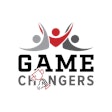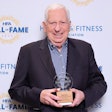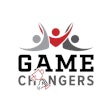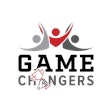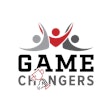
 Photo courtesy Power Forward/Pittsburgh Penguins
Photo courtesy Power Forward/Pittsburgh Penguins
Kevin Stevens skated as the star left wing on a line centered by all-time NHL great Mario Lemieux. They were members of a loaded Pittsburgh Penguins roster chasing the rare Stanley Cup threepeat. Then, during a night out in New York, a fan handed Stevens a vial of cocaine, and everything changed. Weeks later, during Game 7 of the 1993 Patrick Division Finals, Stevens collided with an opposing player and collapsed unconscious to the ice, flattening his nose and crushing his forehead like a potato chip. Even with nine plates screwed into his face, recovery from injury proved easier than recovery from his addiction to cocaine and painkillers. Now clean for 10 years, Stevens tells his story to audiences ranging from youth groups to corporations to college and professional sports teams — a vocation suggested by a judge after the player pleaded guilty in 2017 to conspiring to distribute Oxycodone. AB senior editor Paul Steinbach spoke to the former Boston College All-American, founder of the nonprofit Power Forward and current Penguins scout about the strides he takes every day toward sustained sobriety.
How frequently do you speak to groups?
Probably five, six times a month right now. COVID kind of slowed it down a little bit, but I’ve been out there speaking pretty regularly now. It’s been good. It’s not like motivational speaking. I just tell the truth, and that’s the best thing about it. It might help some people, might not help others. For me, it’s just about telling the truth.
Did you launch Power Forward right away, or did that come later?
We did that a little bit later. We were kind of thinking what we wanted to do and how we wanted to do it, and so my sister and I came together. I always felt the hardest time for addicts or alcoholics is when you get out of rehab — where you’re going to go. For me, it was pretty easy. I had my house still. I didn’t lose completely everything. Most people that go in there, they pretty much lose it all. They don’t have anything when they get out of treatment. Where do they go? So, we came up with the Sober Living plan, where we help people for the next four to six weeks of sober living. That’s what we do. That’s what our foundation does. We pay for people to come out of treatment and get their lives back on track.
What’s the Sober Living plan?
It’s kind of big out here in Boston. When they get out of treatment, most people can’t go back to the place they were, because that’s where they were drinking and using. They don’t want to go back to the street corner. We give them an opportunity to go into a Sober Living house, which is a community, a house with probably 10 to 15 girls or guys, and they’re all trying to do the same thing. Everybody’s trying to stay sober a day at a time, which is a great thing, because you’re around other people who are trying to do what you’re doing. That part was important to me, because that was something I felt like I needed. So, we needed to help people that way.
What do you say to the people you speak to?
I’ve talked to a lot of people, a lot of different groups. There have been kids on hockey teams. I’ve talked to a lot of professional teams, schools, businesspeople. It’s a variety, which is kind of nice. It’s really about awareness. I made a bad decision. That’s what I talk about — choices and decisions. We’re all going to have those choices and decisions, right? I didn’t even know what drugs were. I was 28 years old. I never did anything. I had no idea about anything. I tried something that changed my path for the next 25 years. Not right away, but it was slow and painful.
Is it ever hard for you to revisit these experiences in front of people? Is it even hard for you to speak to me today?
It’s really not. I know where I’m at in my life. I know I’m an addict. I know what I went through. When I go back and think about it by myself, it bothers me. It bothers me because of what I had, what I lost. But I’m not supposed to live like that, so I don’t go back there too often. I try to just move forward and do the things that I’m supposed to do today. But talking about it, I’ve done it so often, and I know it helps. This is what I’m supposed to be doing. I’m supposed to help people. God kept me around for one reason. It wasn’t for the work in hockey. It wasn’t to do all this other stuff. It was to help other drug addicts or alcoholics, and that’s what I like to do.
You mentioned that you didn’t even know what drugs were, but once you discovered that you had a propensity to addiction, did you do any personal research into addiction?
When I got addicted, I didn’t even know what addiction was, to tell you the truth. I know what it is now because I’ve listened, I’ve spent time in the meetings, and I’ve talked to people. So, I definitely know what happens and how it happens and how I became addicted. I activated this gene that I didn’t know I had. If I would have done this at 18 years old, I would have never played an NHL game, ever. I activated at 28, and I was already seven, eight years into my career. Thank God, I had seven or eight good years. And then I had seven or eight really tough years, where I struggled and battled. But when I got addicted, I didn’t know what addiction was. I just thought I was having a good time. I didn’t know what was going on.
You learned that genetics is part of the science of addiction.
I have the addiction genes. I was always a big sports guy. I love playing sports. I played baseball, football and hockey. I liked basketball, too, but I couldn’t play because it was in the hockey season. But I loved all the sports, and I loved playing them, and I worked out really hard. I used to get up in the middle of night and ride my bike, because I knew no one else was riding the bike at that time. I used to do things like that. And you look back and say, “Is that addiction? Is that over the top? Is that pushing it too far?” So, I’ve always had that, but I never put anything in front of it until that night in New York, when I tried cocaine. Then, from there it was, “I want that feeling again — sometime.” It wasn’t right away. I didn’t do coke all the time. I was doing it at all the wrong times, but it wasn’t all the time. I was just doing it when I shouldn’t have been doing it, and then it was starting to kind of call the shots a little bit. The cocaine was a problem, but opiates were the biggest problem. That really called the shots, because you need that every day — plus you’re gonna get sick. Those things started overtaking my drive for hockey, and it’s insane to me, because I never, ever in a million, trillion years thought anything would get in front of hockey. Everything I did in my life was to be a better hockey player. And I loved every bit of it. It wasn’t a struggle for me to go work out for three or four hours. I loved it. I loved everything about it. And this thing took it all. It took that drive. It didn’t take it right away, but it eventually just comes into your life and takes.
If you don’t mind describing it, what did that first experience with cocaine feel like?
It just felt good, I guess. I don’t know what it really felt like, or how it was good or different. It was just different. It got me feeling better. It always gave me more energy. I think it just gave me an upbeat thing. And I never did it alone. I was always with someone.
You were well on your way to NHL stardom, so there was money and access.
I definitely had enough money to do it. I didn’t have tons of money, but I was making a million bucks a year, probably, so I had enough money to do what I wanted to do. It’s just weird. It’s just amazing. I still, today, don’t know how it could get in front of hockey. That amazes me, still.
What was that season like?
It was 1993. We were going for our third Cup in a row, and this year was our best team by far. We ended up losing to the Islanders that year. I ended up getting hurt. We’re playing the Islanders, Game 7, and the first shift of the game I hit a guy, I get knocked out, and I break all the bones in my face on the ice. That’s when the opiates came in. And I didn’t really do the opiates for a while. I didn’t get addicted to opiates until I retired.
Really?
Yeah. I didn’t do any pain pills at all when I was playing. It was always cocaine. I obviously got pain medication in the hospital, but when I got out of the hospital after a couple months, I didn’t do pain pills. I was still stuck on the cocaine.
Interesting.
Honestly, I didn’t even know that I could take pain pills to feel better and get addicted to them. I didn’t know about drugs. I didn’t know.
Do you even recall what was going through your smashed head at the moment of your injury? Do you have any recollection of that?
I recall waking up on the ice, and I saw a couple of my teammates next to me. I didn’t recall hitting the ice. I don’t recall any of that. I just remember I saw the kid coming around the net, and I was coming out of the penalty box. I got a penalty 10 seconds into the game. I was coming out of the penalty box when I hit the kid. And I battled that kid for a long time, so I was kind of looking for him. It was early in the game. You know, emotions are high. Game 7.
The TV announcers mentioned that the visor on the helmet of the player you hit probably caused your blackout. Do you agree with that?
Yeah, that’s what happened. He always used to lead with his head, but he never wore a shield. He hurt his eye a couple of games before that, I think, so he put a shield on. When I hit his shield, I ended up getting 17 stitches on my forehead, over my temple. That’s where I got hit with the shield and knocked out.
Do you agree that if you had been wearing a shield on your helmet that you might not have been injured?
I might not have. I probably wouldn’t have. But back then, most of the guys didn’t wear them. They were kind of rare, still.
Did you start to wear one?
They made me wear one for like six months, and I couldn’t wait to get it off. It just drove me insane, because when you look down, it’s kind of right in your vision. That shield is kind of half and half. It takes some time to get used to them and, obviously, when you have to wear them, you get used to the things. Once the doctor said I could take it off, I took it off.
Shield aside, did the injury itself affect the way you played?
Honestly, everybody points to the injury, right? But I know what the problem was. It wasn’t the injury. I don’t really tell a lot of people that, because I can always use the excuse that I got hurt, and everybody may believe that the injury maybe made me not play as hard.
I know your numbers dipped starting then, but I was just curious. You hear of NFL running backs who blow out their knee and then are a little tentative.
I honestly don’t think it was like that at all.
The hardware that reassembled your face is in your head for the rest of your life?
It never got removed. I know that. So, it’s in there, but it’s so small. It’s how they put people’s heads together, I guess, just like anybody else’s. They say it was like a potato chip. It was real soft up there. I remember when I was on the table during the game, I wanted to go back and play. There were a million doctors in there. It was Game 7. The eye doctor was the one who kind of went underneath my eye, and it was all crushed in there. He said, “You can’t go back.”
I know one of the TV announcers, as you’re being wheeled off the ice on a gurney, said, “He’ll be back.”
Yeah. I would have been back if I could have — I can tell you that much.
You effectively had to have your nose rebuilt. Were your teeth affected at all?
It’s funny. My teeth didn’t get knocked out at all. It was right from my nose up.
Do you still feel pain from that injury today?
No. I don’t feel any pain. I don’t even think about it until we talk about it. I have no side effects.
When did you get into the painkillers?
Right around when I retired. I was in a gym one time, and I hurt my neck, and some kid gave me a Percocet. And then from that time on, it was a 12-year opiate run, and I just battled until I was 50. I was in a gym, someone gave me the Percocets, and I liked them. I didn’t take it daily right away, but then I got stuck on them. And once you get stuck on those things. The problem with pain medication, if you’re addicted and you like it, it makes you feel better, why wouldn’t you take it, right? I don’t feel any pain. It makes me feel better. Why wouldn’t I take this? And then the next thing I know, I’m stuck on it. And then I’m really in trouble.
I went on a Netflix binge one weekend and learned everything I could about Oxycodone.
Oh, you did? Yeah, it’s insane. It’s insane that the drug is so addictive, and it’s terrible. It’s a terrible, terrible drug. And you could get it anywhere. There was a point in time where I’d go to Florida, go to five or six different doctors in a day, and get 80 pills, 90 pills from each doctor. Yeah, I did stuff like that. I didn’t go to Florida a lot, but I sought out doctors who would give them to me. You could always find a doctor like that who will give them to you, and you kind of stay with that doctor. And they overprescribe it like crazy.
This was after you retired, so you never played hockey under the influence.
No. With cocaine, I didn’t play on it myself, but it affected everything I did.
You said you had little drug awareness during your playing days. No sense for what other NHL players might have been doing?
I don’t really know. Obviously, it comes out afterward that some guy’s stuck on coke, or whatever. You never hear it when you’re playing. No one’s telling each other, “You know, he’s doing this stuff.” It’s not something that you want to get out there, because it’s impossible to play in the league when you’re doing drugs. It’s too hard. For me to hang around for seven years is amazing that I could do that. The game is just too hard.
Do you have any feel for how prevalent substance abuse in general is in professional sports?
I think it’s there. In hockey, I think alcohol is a big one, because you can’t play on drugs. You can’t stay up all night doing cocaine and try to play hockey. It doesn’t work. You’re gonna be out of the league. But alcohol is one of those drugs — it’s something that you think you can always get out of your system. You do it one night. But it’s just like anything else. You can get stuck on that, too. So, it’s there. When you’re in the game and you have money, there are a lot of things you can get into.
When you’re speaking to professional and college teams, what’s the message? Do they realize that this is something that could be a problem?
I just tell them exactly what happened. Opportunities are going to be available. It’s about you making a choice and a decision. I didn’t know. I tell them I was playing with Mario Lemieux, the best player in the world. I was his left wing. I just won two Stanley Cups. I scored back-to-back, 55-goal years. Scored a bunch of playoff goals. If you wanted someone’s life, you wanted mine. My life couldn’t have been any better. And I made a choice that night in New York. I just tell them the exact truth. This is what happened because I put myself in a position. You’re going to be in positions where fans are on you. Everybody wants to be around you. They all want to be hanging out with the hockey guys, and people are going to hand you stuff or give you opportunities to do stuff. You have to have a clear conscience, and you have to say no. You can’t make a bad choice. And, now, you can’t make a bad choice, because you’ll die. That’s the biggest thing, because of this fentanyl out there. Now you make a bad choice, we’ve seen guys in the NHL not wake up the next day.
Being surrounded by that kind of attention has to be intoxicating all by itself.
For a long time, it was great. I loved it. It didn’t bother me at all, until I made that choice and that decision that changed everything. I liked being on the team that everybody wanted to beat. I liked being on a good team where we could win every game. I loved being with my teammates. I loved being a good teammate.
I’ve heard them describe you as being a locker room presence that everyone wanted to be around.
I loved playing hockey. I loved what I did. I loved trying to win. Well, what better job is there than that? When I woke up every morning, all I had to do was try to beat the Rangers or beat the Devils or beat the Capitals. That’s a pretty good job, I think.
Then, at age 34, you were with the Rangers, and you were caught smoking crack cocaine.
Yeah, that’s why I got arrested in St Louis. That’s when it all came to a head out there. I was hurt, I wasn’t playing. And then I went out one night, and that’s all they had out there, so that’s the first time I tried crack.
Is that a different high?
Yeah, that was different. It’s all different. It’s all addictive. Same thing.
You were in a car accident in 2014. Were you under the influence?
Yeah, that wasn’t good. That was not a good thing. I wasn’t in the best shape. I don’t know if I was using right then, but it was from using that I was tired.
It was a head-on collision that sent you into the windshield. Did you re-injure any of your previous facial injuries?
No, but I broke my neck. I was lucky. Really lucky. I had nine hours of surgery. I should be dead 50 times over. I’m very lucky to be here, and I realize that now. I have to spread the message. There’s really only one reason that I’m here.
In 2015, the FBI arrested you, and you had to spend some time in custody?
Yeah, six or seven days.
You could have been sentenced to 18 months, but the judge spared you with marching orders to do good.
Yeah, that’s pretty much it. “I’ll let you go, but you have to do some work for me.” And that’s when I started speaking. I stayed sober. I had to work on myself first. I had to get myself right. It doesn’t matter what you’ve done and what you haven’t done, it’s hard to stay sober. It’s hard when you’re an addict. So that was most important for me — to get my life in order. Then, once I got my life in order, I could go out and help people, but I had to get my life in order first.
And you’re there? You feel good?
Yeah, I feel good now. I feel really good.
When you’re in front of an audience, what do you see and hear?
I’ve been in those groups. I sat in those auditoriums and said, “What the heck’s this guy talking about? What’s he doing here?” But the biggest thing for me is to hit the person who really doesn’t want to be there, but they’re listening anyway, and they hear something they need to hear. They’re just struggling at home, someone’s hurting at home, or something’s going on, and they just hear something by chance because they’re there. I think that’s the biggest thing we have to do. We have to get out there in front of people. Even the kids who don’t want to be there, they hear something. There’s always a message that can be heard, and a lot of times it’s the person who doesn’t even want to hear it.
Do you receive feedback after you’ve made an appearance?
Yeah, I’ve had people come up to me afterward. Kids even say that they heard something that’s going to help them. That’s why you do it. If you can help one person that day, it’s worth being there.
And have you ever had someone who was in the throes of addiction, saw you speak and then reached back to you and said, ‘Hey, I’m clean now’?
Yeah, we’ve had people do that. I’m speaking to rehab. I’m speaking to people in treatment. I speak to all those people. You see them afterward at meetings, and they’re doing well, so it’s nice to see that. That’s why you do it. You do it because the message needs to be out there. It has to be said. The people who are struggling need to hear a message of hope.
It has to be therapeutic for you.
Yeah, I need to do it for me. It helps other people, but it helps me, too. That’s big.


























